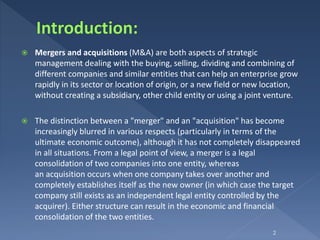Mergers and Acquisitions
- 2. Mergers and acquisitions (M&A) are both aspects of strategic management dealing with the buying, selling, dividing and combining of different companies and similar entities that can help an enterprise grow rapidly in its sector or location of origin, or a new field or new location, without creating a subsidiary, other child entity or using a joint venture. The distinction between a "merger" and an "acquisition" has become increasingly blurred in various respects (particularly in terms of the ultimate economic outcome), although it has not completely disappeared in all situations. From a legal point of view, a merger is a legal consolidation of two companies into one entity, whereas an acquisition occurs when one company takes over another and completely establishes itself as the new owner (in which case the target company still exists as an independent legal entity controlled by the acquirer). Either structure can result in the economic and financial consolidation of the two entities. 2
- 3. Merger: A transaction where two firms agree to integrate their operations on a relatively co-equal basis because they have resources and capabilities that together may create a stronger competitive advantage. Example: Company A + Company B= Company C. Acquisition: A transaction where one firms buys another firm with the intent of more effectively using a core competence by making the acquired firm a subsidiary within its portfolio of business Example:Company A + Company B= Company A. 3
- 4. i. Merging of two organization in to one. ii. It is the mutual decision. iii. Merger is expensive than acquisition(higher legal cost). iv. Through merger shareholders can increase their net worth. v. It is time consuming and the company has to maintain legal issues. vi. Dilution of ownership occurs in merger. i. Buying one organization by another. ii. It can be friendly takeover or hostile takeover. iii. Acquisition is less expensive than merger. iv. Buyers cannot raise their enough capital. v. It is faster and easier transaction. vi. The acquirer does not experience the dilution of ownership. 4
- 5. M&A Market-extension merger Two companies that sell the same products in different markets Product-extension merger Two companies selling different but related products in the same market Conglomeration Two companies that have no common business areas 5
- 6. Adani Enterprises takes over Abbot Point Coal. The Vedanta – Cairn acquisition. Mahindra & Mahindra acquires Ssangyong Motors. Aditya Birla Group acquires Columbian Chemicals. Kotak Mahindra Bank acquired ING Vysya Bank. iGate completes acquisition of Patni Computers. Vodafone acquired Hutch. Hindalco acquired Novelis. HDFC Bank acquires Centurion Bank of Punjab. Tata Motors acquires Jaguar and Land Rover. Snapdeal acquires Freechage and GoJavas. DHL-Bluedart Merged. OLA Cabs acquires TaxiForSure. Tech Mahindra acquired Satyam. 6
- 7. Approval from Board of Directors, Information to the stock exchange, Application in the High Court, Shareholders and Creditors meetings, Sanction by the High Court, Filing of the court order, Transfer of assets or liabilities, Payment by cash and securities. Total period: 210+ days. 7
- 8. Understanding the markets. Accessing the markets. Overcome the entry barriers. Synchronization of customers. Increase market share. Risk minimization. Restructuring Plans. Economies of large scale. Reducing competition. Expansion and Growth. Surplus Resources. 8
- 9. Product , services and business diversification. Developing new product mixes. 9
- 10. Integration difficulties. Huge debt. Costs underestimated. Decrease in R&D activities. Change in management’s objectives. Over diversification. Inability to Achieve Synergy. Inadequate Evaluation of Target. 10
- 11. 11 THANK YOU










